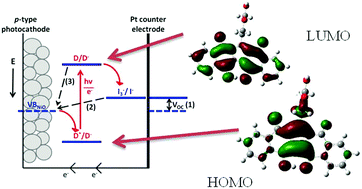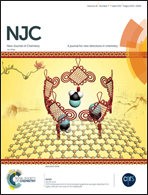KuQuinones as sensitizers for NiO based p-type dye-sensitized solar cells†
Abstract
A new series of KuQuinones (KuQs) have been synthesized and employed as dye-sensitizers for NiO-based p-type dye-sensitized solar cells (p-DSSCs). KuQs are pentacyclic quinoid compounds which are characterized by a fully conjugated structure that is responsible for the strong and broad absorption in the visible spectrum. The HOMO/LUMO states of KuQs considered here have matching energy levels with the upper edge of the NiO valence band and I−/I3− redox potential energy. These features render such compounds suitable for NiO sensitization in p-DSSCs. The new carboxylic acid-substituted KuQ derivatives proposed here differ in the length of the alkyl chain. The JV characteristic curves and the external quantum efficiency spectra have been recorded. The results showed that the performances of KuQ-sensitized cells were similar to that of the benchmark sensitizer erythrosine B (Ery B), despite the lack of electronic conjugation between the anchoring group and the light absorbing unit. This result led us to hypothesize that the photoinduced charge transfer between the excited KuQ dyes and the NiO electrode occurred through space and not via chemical bonds as it usually occurs in these systems. The mechanism of charge transfer through space has been supported by data from IR spectroscopy.



 Please wait while we load your content...
Please wait while we load your content...